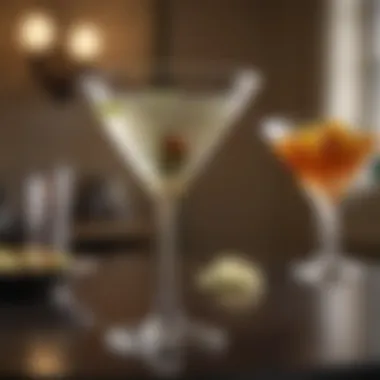Mastering the Art of the Perfect Martini


Intro
In the world of classic cocktails, the martini stands as an unwavering symbol of sophistication. Its crisp, clean taste and polished presentation have made it a staple in bars and homes for generations. Delving into the perfect martini is not just about mixing spirits; it's about embracing a tradition that combines history, technique, and personal preference.
Traditionally, a martini consists primarily of gin and vermouth, often garnished with an olive or a twist of lemon. The discussions surrounding this iconic drink often branch into realms of opinion and preference. Some swear by the classic gin martini, while others lean towards vodka. There are those who push for an extra dash of vermouth, and some who insist that less is more. What makes a martini perfect, however, varies from individual to individual.
This exploration will guide you through the elaborate landscape of martini-making, from understanding the essential ingredients to discovering the delicate balance between them. We will also touch on various styles, approaching garnishes, and the significant role of glassware that can elevate your experience. Whether you enjoy a traditional rendition or prefer to experiment with modern twists, our goal is to offer insight into crafting a martini that resonates with your taste and ethos.
Let's embark on this journey to define what makes a perfect martini, examining the details and the subtleties that can transform this simple cocktail into a remarkable experience.
Recipe Overview
- Recipe Name: Classic Gin Martini
- Brief Description: A timeless cocktail that embodies elegance and simplicity, blending premium gin with dry vermouth and served with a zest of lemon or an olive.
Prologue to the Martini
The martini stands as an emblem of cocktail culture, conjuring up visions of sophistication and elegance. It's not merely a concoction of spirits; it represents a lifestyle, a garnish of culture, and a touch of history. Understanding its origins and significance sets the stage for any deep exploration into what makes a perfect martini.
From the glitzy bars of Manhattan to an intimate gathering around a cozy fire, the martini has weathered the storm of changing tastes and trends. Even as trends evolve, the essence of a well-crafted martini remains a benchmark for those seeking both precision and artistry in their drinks. This section focuses on why the martini matters in the broader cocktail scene and how it reflects varying preferences and local customs.
Historical Context
The martini's lineage can be traced back to the latter half of the 19th century, sitting comfortably on the timeline between various cocktails that paved the way for modern mixology. The exact roots seem a bit muddied, with tales linked to different regions and patrons. Some claim that a gold miner named Julio Richelieu first concocted it in San Francisco, while others affirm that it was birthed in New York during the early days of the Manhattan. As it happens, many stories float around, yet they share a common thread: the desire for something refreshing yet potent, something that instantly makes one feel a cut above the rest.
"The martini’s journey showcases how culture and taste can intermingle, reflecting societal changes just like art or music."
Throughout Prohibition, when liquor was scarce, it became a staple among the elites who could still access it. It’s curious to note how the martini evolved from a genteel drink to a more casual refreshment—symbolizing both rebellion and refinement over the decades.
Cultural Significance
In terms of cultural impact, the martini serves as a mirror to society, revealing much about our preferences and traditions, perhaps more than we realize. Its presence in popular culture—from James Bond's iconic preference for a "shaken, not stirred" to countless cinematic scenes that featured glamorous social gatherings—cements its place in our collective consciousness.
People associate the martini with not just drinks at the bar but with states of mind and lifestyles. It's imbued with an aura of celebration or intimacy, and the choice of gin or vodka, dirty or dry, creates personal narratives around each sip.
Taking a closer look, you’ll find:
- The martini as a symbol of sophistication
- Its role in film and literature that reflects societal values
- Variations in custom that tell unique stories from different regions
Each time a glass is raised, it whispers tales from the past, blending them with the present. This strong cultural pedigree elevates the martini from mere beverage to cherished tradition—one worth savoring and honoring, regardless of your choice of spirit.
Defining the Perfect Martini
The martini, a timeless symbol of sophistication, holds an irreplaceable spot in mixology and cocktail culture. Defining the perfect martini involves not only the selection of ingredients but also an understanding of personal taste. The precision in crafting this drink is a testament to the craftsmanship behind it, blurring the lines between tradition and modern innovation. The importance of thoroughly exploring this topic is paramount because it influences how individuals experience this iconic beverage. The martini can range from being strikingly simple to astonishingly complex, depending on how one opts to define it.
Personal Preferences
In the world of martinis, personal preference reigns supreme. Each individual brings their own flavor profile, memories, and experiences to the glass. Some folks swear by gin for a classic touch, while others lean towards vodka, believing it produces a smoother experience. The debate doesn’t end there; it spills into vermouth varieties, bitters, and even the choice of garnishes. A well-crafted martini isn’t just about a collection of ingredients; it’s about striking harmony between flavors that speak to the drinker’s palate.
Key elements to consider:
- Spirit Base:
- Vermouth Choice:
- Garnish Preferences:
- Gin lovers may argue for the botanical richness as a defining quality, while vodka drinkers often claim it allows the vermouth to shine.
- Whether opting for dry, sweet, or something in between, the type of vermouth can dramatically shift the drink's profile.
- Some swear by olives, while others prefer a lemon twist. Even choosy drinkers can have a say in whether to include extra nuances like a cocktail onion, creating a martini that resonates uniquely.
Classic vs. Contemporary Versions
The evolution of the martini embodies a fascinating juxtaposition between the classic standards and contemporary interpretations. When one thinks of a classic martini, the image that springs to mind is often that of a gin martini, stirred with care, and served in a chilled glass, accented with a simple olive. This traditional take captures what many consider the essence of a martini – elegance and clarity.


Conversely, contemporary versions have burst onto the scene, broadening the horizons of what a martini can truly be. These modern interpretations infuse bold flavors, innovative infusions, and sometimes unexpected ingredients. You might find martinis that include flavors like cucumber, elderflower, or even jalapeño for a spicy kick. Each version, whether rooted in tradition or daringly new, reflects the drinker’s personality and the social environment in which it’s enjoyed.
"At its core, the martini is not just a drink – it’s an experience shaped by personal choices and cultural influence."
Understanding this interplay between classic ideals and modern inventiveness is crucial to grasping the full narrative of martinis. It also serves as a reminder that at the end of the day, the ideal martini is one that resonates with the individual enjoying it.
Ingredients Analysis
When it comes to crafting a martini, the importance of the ingredients cannot be overstated. After all, these elements work in harmony to shape the very character of the drink. In essence, the ingredients are the backbone of any martini experience; they dictate taste, aroma, and even the presentation that is so crucial in cocktail culture.
Using the right types of gin or vodka, together with quality vermouth, not only elevates flavor but also showcases the mastery involved in making a perfect martini. Fleeting trends may come and go, but a deep understanding of these core components will ensure that one's martini never strays too far from perfection.
Moreover, each ingredient carries its own narrative—be it through historical significance, regional specificity, or the artistry involved in its crafting. Thus, selecting the right ingredients is about more than just taste; it’s about creating an experience that resonates with the drinker on multiple levels. Below, we will delve into the specifics of two principal elements that contribute to the ideal martini: gin and vodka, followed by a look into the world of vermouth varieties.
Types of Gin and Vodka
Gin and vodka stand as the most common base spirits for martinis, each bringing unique characteristics to the table.
- Gin: Infused with botanicals, gin often adds a complex layer of flavor. The variety in gin is astounding—think London Dry, Old Tom, or even the newer craft gin options. Each offers distinct botanical profiles, ranging from herbal to citrus notes. A gin lover might lean towards a classic Tanqueray or Hendrick's, which is famed for its cucumber essence.
- Vodka: While vodka is typically known for its neutrality, the subtleties in quality and craftsmanship can make a considerable difference. Brands like Grey Goose or Belvedere are praised for their smooth finish, which can provide a blank canvas that allows other flavors in the drink to shine.
Choosing between gin and vodka often depends on personal preference, mood, and even the occasion. Both spirits serve to define your drink's character:
- For a more herbal and aromatic experience, gin shines.
- For a smooth and clean profile, vodka is the go-to choice.
"The spirit you choose transforms your martini from an ordinary drink to a personalized experience."
Vermouth Varieties
While gin and vodka form the base, vermouth adds that essential touch of sophistication and balance to a martini. It is an often overlooked, yet crucial, component. Vermouth can elevate the flavor profile, offering sweetness, bitterness, or even herbal notes. Here’s a closer look:
- Dry Vermouth: Usually characterized by a crisp and slightly bitter taste, dry vermouth is common in many martini recipes. Brands like Noilly Prat and Dolin offer excellent options. A splash can brighten the drink, giving it the refreshing edge that many seek.
- Sweet Vermouth: For those opting for a sweeter blend, sweet vermouth brings a rich, complex flavor that can transform the drink entirely. Carpano Antica is a notable choice that adds layers of aromatic depth with its notes of vanilla and spices.
- French vs. Italian: Additionally, the choice between French and Italian vermouth can significantly influence the final taste. French vermouth tends to be lighter and drier, while its Italian counterpart often lends a deeper sweetness.
By taking the time to explore these different types of gin and vodka and the nuances of vermouth, one ultimately develops a more refined palate—not just for martinis, but for all cocktails. Each sip can serve as a testament to your choice of ingredients, underscoring the art in every aspect of cocktail creation.
Crafting the Martini
Crafting the perfect martini is not merely an art; it's a practice steeped in tradition and personal expression. For those who appreciate the balance of flavors and the nuance of ingredients, understanding the process can elevate the experience from mundane to mesmerizing. The act of crafting a martini isn’t just about combining gin or vodka and vermouth. It involves a philosophy that can enhance any gathering or quiet night at home.
In this section, we will delve into the specific techniques of mixing an exceptional martini, exploring the various methods that can alter the drink’s essence. The importance of one’s method can have profound effects on flavor, texture, and even the aesthetic of the drink. These considerations are essential for both novice and experienced mixologists alike.
Mixing Techniques
When it comes to mixing a martini, the technique you choose is critical. The act of mixing can affect not just the temperature but also the dilution and overall flavor profile. Here are a few methods to consider when crafting your ideal drink:
- Stirring: A classic approach, stirring is all about maintaining that balance. It gently combines the ingredients without introducing too much air. When you use a long-handled bar spoon, the motion can create a lovely, silky mouthfeel. It’s always recommended to use a mixing glass and plenty of ice. A well-stirred martini typically expresses clarity and allows the nuanced flavors of the gin or vodka to shine.
- Shaking: This method is often associated with a bolder, more audacious martini. Shaking introduces air and, hence, a frothier consistency. It’s particularly popular for cocktails that contain fruit juices or syrups, but some prefer it to be shaken for certain styles of martinis, like a dirty martini. The coldness achieved by shaking is undeniable, offering a refreshing sip each time.
- Layering: For the experimental at heart, layering can create visually stunning presentations. Pouring various ingredients gently over the back of a spoon can produce a beautiful gradient effect in the glass. While this is less common, the visual appeal can lead to an interesting conversation piece.
Understanding each of these techniques will not only refine your skills but also enable you to express your own taste. Everyone has a personal preference, and embracing that will help you in tailoring the martini to fit your unique palate.
Shaken vs. Stirred
The debate surrounding whether a martini should be shaken or stirred is fierce yet whimsical. Each camp has its advocates, each presenting valid arguments grounded in experience as well as fervor. Here’s a closer look at what sets them apart.
Shaken:
When you shake a martini, you're essentially activating the ingredients in a more vigorous manner. The ice pebbles break down more swiftly, leading to a colder drink with increased dilution. This method works wonders in creating an invigorating texture, making it especially palatable for those who enjoy a brisk finish. For example, a well-shaken dirty martini with its olive brine can pack a punch.
Stirred:
On the other hand, stirring maintains the integrity of the drink's components while providing control over dilution. Purists often align with stirring as it fosters a soft blend of flavors without the overwhelming chill that shaking introduces. Some argue that shaking over-stimulates the ingredients, causing them to lose their complexity. Ultimately, if you're aiming for a clean, sophisticated sip, stirring might be the pathway to achieving that.
This choice isn't just physical; it reflects a deeper understanding of the drink you're crafting. By assessing the ingredients and your own taste preferences, you can make an educated decision on the method that best suits your style.
"A martini should always be made just the way you like it, shaking up the norms while preserving what truly matters to you."
The craft of a martini merges art and science. Whether you prefer it shaken or stirred, understanding these foundational techniques will pave the way for you to personalize the experience further and enjoy a cocktail that resonates with your own ideals.
Garnishes and Their Importance


When it comes to martinis, garnishes are not just an afterthought; they play a crucial role in the overall experience. The choice of garnish can elevate a drink, imparting flavor and aesthetics that are as significant as the ingredients themselves. A garnish is often the first thing that catches the eye and can set the mood before the first sip even hits the lips. The right embellishment not only complements but enhances the concoction, catering to both tradition and personal flair.
A well-chosen garnish brings harmony to the mix. It can offer contrast and balance, adding a layer of complexity that is often overlooked. Whether it is the briny depth of an olive or the fresh zestiness of a citrus twist, the choice reflects one’s taste and the intended vibe of the gathering.
Here are several reasons why garnishes matter:
- Flavor Enhancement: Garnishes can introduce additional flavors, lifting the drink from ordinary to extraordinary.
- Visual Appeal: A beautifully garnished drink is inherently more enticing, enhancing the drinking experience before it even begins.
- Tradition and Ritual: Some garnishes carry historical weight, grounding the cocktail in its origins and culture.
The importance of garnishes goes beyond mere aesthetics; they are an integral part of a well-crafted martini.
Olives: The Traditional Choice
Olives have long held a place of honor as the traditional choice for martini garnishes. Their briny flavor pairs exquisitely with the cold, crisp nature of gin or vodka, adding an umami punch that many drinkers crave. Selecting the right olive can be a personal journey, as varieties differ vastly in flavor and texture.
Typically, the green olive takes the lead, often stuffed with pimento or garlic. Some prefer the more robust black olives, which offer a richer depth. A common practice seen in upscale bars is to serve martinis with a skewered olive, presenting it elegantly on a cocktail pick. This not only looks sophisticated but makes for a more enjoyable sipping experience.
Beyond flavor, the choice of olive can signify a preference. For instance, choosing a blue cheese-stuffed olive indicates a penchant for extravagance while a simple green olive suggests a classic approach. Each choice reflects an individual’s personality and enhances the cocktail's narrative.
"Sometimes, the olive speaks louder than the drink itself."
Twists of Citrus: An Alternative
For those who favor a refreshing contrast, twists of citrus—typically lemon—serve as a delightful alternative. The zest of the lemon, when twisted over the drink, releases essential oils that mingle with the alcohol, providing a bright aroma that can invigorate the senses. The sharpness of the citrus cuts through the richness of the martini, offering a refreshing balance.
Using a twist rather than a wedge is a subtle but impactful choice. It contributes minimal juice yet maximizes the essential oil presence, ensuring the drink remains dry while enhancing both aroma and flavor. Additionally, the visually appealing spiral adds a touch of elegance to the drink, catching the eye and inviting curiosity.
Lemon twists align well with a wide range of modern interpretations of the martini, especially those that lean towards the refreshing side of cocktails. They symbolize a more contemporary approach, appealing to those who prefer a cleaner and crisper taste.
As we explore these garnishes, it's clear that the decision lies in the drinker’s hands—whether to honor the rich tradition of olives or embrace the zesty allure of citrus twists. Each garnish invites a unique experience, allowing for personalization and creativity in an endlessly adaptable cocktail culture.
Glassware Considerations
The glassware used when serving a martini is not just a receptacle; it's an integral part of the experience. The choice of glass impacts not only the presentation but also the overall enjoyment of this iconic cocktail. A well-selected glass can enhance the aesthetic appeal and ensure that every sip is savored at its best. Understanding the nuances of glassware helps in perfecting the art of the martini.
The Classic Martini Glass
Often referred to as a coupe, the classic martini glass is characterized by its distinctive stem and wide, shallow bowl. This design isn’t merely for show; it serves several practical purposes.
- Temperature Control: The design allows for greater surface area, helping drinks chill quickly while allowing for easier swirling.
- Aromatic Experience: The wide bowl enables the botanicals or flavors of the gin, or vodka, to be fully released, allowing the drinker to appreciate the aroma before taking a sip.
For aficionados, the choice of a classic martini glass might evoke a sense of nostalgia reminiscent of glamorous parties or cinematic scenes. It brings a touch of history into each drink, grounding the modern in the past. This glass has become synonymous with sophistication and class, a ready stage for the distinctive appearance of a well-crafted martini.
It’s worth noting that different sizes of the classic martini glass can impact the drink's overall experience. A larger bowl may allow for more space and therefore a more relaxed atmosphere, while a smaller bowl might encourage a quick, elegant indulgence. Regardless of size, though, the essence of a classic martini glass is its timeless charm.
Alternative Serving Options
While the classic martini glass often steals the show, there are several alternative serving options that cater to individual tastes and modern trends. Experimenting with different glassware can add a unique twist to the martini-drinking experience.
- Nick and Nora Glasses: These smaller, stemmed glasses are reminiscent of the Prohibition era, providing a vintage feel while maintaining elegance. They also offer concentrated aroma, much like the classic style.
- Rocks Glass: For those who prefer a more casual approach, a rocks glass creates a relaxed and friendly vibe, suitable for sipping while enjoying the company of friends.
- Highball Glass: This choice lends itself to a longer drink experience, great for cocktails that might not strictly be a martini but still share similar flavors.
When it comes to serving a martini, the glass is as important as the spirits within it.
Each alternative glass brings its own character to the cocktail. The essence of a perfect martini lies not only in the ingredients but also in how it is perceived and enjoyed. Through these variations, imbibers can find the combination that suits their style, inviting creativity into the age-old ritual.
In summary, the considerations for glassware extend beyond mere aesthetics, all the way to enhancing the flavors and aromas of the martini itself. The right choice of glass allows each person to define their own martini experience, be it traditional or innovative.
Regional Variations
When it comes to martinis, variances stretch far beyond just personal preferences for gin or vodka. The discussion on regional variations unveils how culture, geography, and local ingredients shape the cocktail. Each region boasts its own unique twist, providing depth and richness to the classic recipe. Understanding these variations can enhance our appreciation for martinis while influencing our choice of preparation methods.
Exploring regional differences not only opens our eyes to new ways of enjoying this cocktail, but it also allows us to connect with history and tradition behind each recipe. Countries and even cities often put their own spin on the classic martini, adapting it to local tastes. The importance of this section lies in recognizing how our surroundings inform our cocktail experience.


American Variants
In the United States, the martini has evolved in fascinating ways, reflecting the dynamic nature of American culture. The classic dry martini remains popular, but several variants have emerged, taking advantage of local preferences and ingredients.
For example, a common favorite is the dirty martini, which incorporates olive brine into the traditional mix. This variation adds a salty, savory layer that contrasts beautifully with the spirit's crispness. Many Americans also enjoy garnishing theirs with a blue cheese-stuffed olive, adding an extra twist, both in flavor and presentation.
Another interesting version is the vodka martini. For many, vodka's neutrality serves as an appealing counterpart to vermouth. Bartenders may garnish this drink with a twist of lemon or even a cocktail onion, transforming it into a Gibson. Each American variant tends to draw attention, making them widely recognized and often served in bars across the nation.
"In America, the martini is often characterized by its inventiveness; each twist reflects not just taste but also the identity of its drinkers."
European Influences
On the other side of the Atlantic, Europe has also made its mark on the martini scene. European influences often embrace a more traditional approach, favoring classic styles and high-quality, artisanal ingredients.
For instance, the Italian martini features a signature touch of sweet vermouth, blending Italian charm with the cocktail's roots. Some regions may incorporate local bitters or even herbs, enhancing flavors while emphasizing regional identity.
In countries like the UK, the London Dry Martini is renowned for its botanical blend of gin, boasting a dry finish that highlights the spirit’s refreshing notes. The catchy term “Noilly Prat” garners applause, as it refers to a certain French vermouth that's frequently chosen for its distinct flavor profile.
Ultimately, each country contributes its own character to the martini, proving that this cocktail can be shaped and reshaped by geography and taste preferences.
By exploring both American variants and European influences, enthusiasts of the martini can discover a broader spectrum of ways to enjoy this timeless drink. Each variation tells a story, offering a little glimpse into the essence of the culture it hails from.
Modern Trends in Martini Consumption
The landscape of cocktail culture has been evolving, with the martini experiencing a noteworthy transformation due to modern trends in its consumption. Understanding these trends is essential for both enthusiasts and serious mixologists alike, as they reveal shifts in preferences, presentation, and overall experience. In our current era, where personalization and creativity reign supreme, the martini remains at the forefront of this cocktail renaissance.
As people's palates change, so does the way they perceive classic drinks. The traditional martini still holds a special place in many hearts, but its modern counterparts challenge the status quo, inviting new interpretations. This section will explore the essential elements shaping today’s martini landscape, highlighting the benefits and thoughtful considerations of these movements.
Craft Cocktail Movements
Craft cocktail movements have surged in popularity, often associated with a return to artisanal techniques and a focus on high-quality, fresh ingredients. Bartenders today are not just mixologists; they become storytellers through their drinks. The martini, often seen as a simple two-ingredient cocktail, offers a blank canvas for creativity.
- Local Sourcing: Many trendy bars are opting for locally sourced spirits and fresh garnishes. This emphasizes flavor profiles that resonate with the community.
- House-made Ingredients: Infused spirits or DIY vermouths are becoming commonplace. For example, a rosemary-infused gin can give a unique twist to the classic drink, offering a new aromatic experience.
- Mixology Techniques: The techniques used have evolved as well. Many mixologists are employing methods like sous-vide for infusions or barrel-aging cocktails to enhance complexity.
The craft cocktail movement emphasizes not only the drink's flavor but also its narrative. Each craft martini tells a story of taste, local culture, and personal preference, forming a deeper connection with the consumer.
Infusions and Flavor Innovations
Infusions and flavor innovations are pivotal in creating novel martini experiences. This modern trend speaks to the adventurous spirit of today's drinkers, who seek out unique tastes over traditional profiles. More than ever, people crave flavors that surprise and delight.
- Flavor Infusions: From exotic spices to unusual fruits, infusions allow drinkers to explore new territories. For instance, incorporating cucumber and mint provides a refreshing twist.
- Bold Pairings: Unexpected combinations, such as combining gin with elderflower liqueur or even spicy jalapeño can enhance the classic martini and cater to a variety of tastes.
- Experimental Techniques: The use of smoke or foam has entered the arena, elevating the sensory experience associated with drinking a martini. Creating a smoked martini adds a layer of depth that engages the palate.
As bartenders experiment with these infusions, they not only redraw the lines of tradition but also invite drinkers to partake in a more personalized experience. This multilevel approach to flavor can result in an unforgettable night out, expanding the drinker’s horizons while keeping their favorite martini at heart.
"The perfect martini is a fusion of tradition and innovation; it evolves as the world does."
Closure: Personalizing the Perfect Martini
The personalized martini is not just a drink; it is an expression of individuality and creativity. In this exploration, we’ve seen how the martini has evolved through the ages, but its true essence lies in the hands of the drinker. Each choice, from the type of spirit to the garnish, reflects personal taste and preferences. This culmination of experiences and decisions results in a drink that is uniquely yours.
The Journey of Experimentation
Experimenting with martinis can be as thrilling as it is daunting. The search for the perfect mix can lead one down unexpected paths, opening doors to a world where flavors blend to tell a story. Consider this: trying a lillet or even an aperitivo in place of traditional vermouth shifts the character of your martini entirely. The addition of an herbal infusion, like rosemary or thyme, introduces more complexity and surprises. By stepping outside traditional norms, you might find a flavor combination that resonates with you in ways you never imagined.
"A martini is not just a drink; it's an adventure for your palate."
It's not just about sticking to the old rules. Have fun with it. Measure your botanicals, taste as you go, and don’t fear missteps. Some of the best innovations have come from chefs or bartenders whose first attempts hardly hit the mark. Keeping an open mind, adapting along the way, and sharing the results with others enhances the experience. It is a journey meant for discovery, delight, and perhaps, a bit of laughter.
Defining Your Own Standard
Defining personal standards is paramount in any craft — martini-making included. What makes a perfect martini for you might differ vastly from another's ideal. Maybe you adore the sharp bite of a dirty martini with olive brine, or perhaps you prefer it dry, where the gin's botanicals sing with clarity. These inclinations shape your benchmark.
Take a moment to think about the qualities you value:
- Flavor Profile: Is it savory or sweet? Strong or subtle?
- Aroma: What scents bring you back to a cherished memory?
- Presentation: Does a particular glassware enhance your drinking experience?
Defining your standard doesn’t mean adhering to a strict formula. Instead, let your standards evolve as your palate does. They can shift with seasons, moods, or even groups with whom you share a cocktail. Sharing ideas and observations can also refine your perspective and open avenues to new favorites.
In the end, a martini is more than just a cocktail. It’s a medium for self-expression, a celebration of flavor and creativity. As you personalize your martini experience, remember that it is this very journey—filled with experimentation and personal benchmarks—that fosters a deeper appreciation for this iconic drink.







